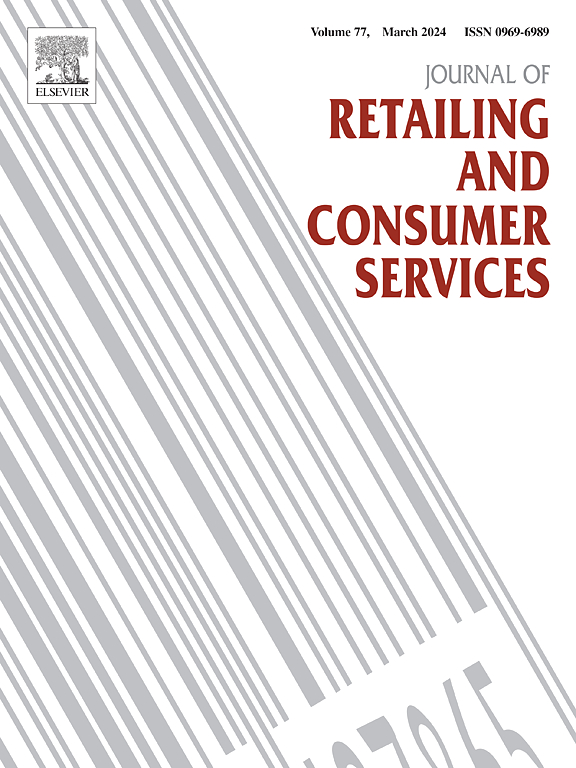一个新的品牌社交媒体计划?虚拟网红与品牌追随者关系研究
IF 11
1区 管理学
Q1 BUSINESS
Journal of Retailing and Consumer Services
Pub Date : 2025-01-31
DOI:10.1016/j.jretconser.2025.104241
引用次数: 0
摘要
使用虚拟网红已经成为社交媒体平台上品牌营销策略的重要组成部分。这种方法提供了一种新颖的营销形式,可以实现深度参与、高可控性和成本效益。然而,研究人员对这一现象的研究还不够充分。为了进一步研究品牌的虚拟网红与其粉丝之间的关系,我们创建了一个综合数据集,其中包括2023年9月1日至2024年3月31日期间品牌在TikTok上使用虚拟网红发布的30,090条内容。我们的研究结果对品牌利用虚拟影响者的方式产生了一些重要的见解。首先,之前的研究集中在虚拟影响者对其追随者数量的潜在积极或消极影响上。我们的研究结果表明,品牌使用虚拟网红对其社交媒体关注者数量的影响并不遵循直接的线性轨迹。相反,它呈现出倒u型关系。其次,用户行为在品牌虚拟影响者和品牌关注者之间起中介作用。具体而言,品牌虚拟网红与社交媒体用户参与行为和用户转发行为之间存在受影响的u型关系,而社交媒体用户参与行为和用户转发行为又会影响品牌关注者数量。此外,我们还发现虚拟网红互动行为调节了虚拟网红与用户参与行为和用户转发行为之间的倒u型关系。本研究创新性地引入了“恐怖谷效应”的视角,揭示了虚拟网红与品牌追随者之间关系的复杂性,并为品牌制定利用虚拟网红的有效策略提供了一个全面的框架。本文章由计算机程序翻译,如有差异,请以英文原文为准。
A new social media programme for brands? A study of the relationship between virtual influencers and brand followers
The use of virtual influencers has become a crucial component of brand marketing strategies on social media platforms. This approach offers a novel form of marketing that enables deep engagement, high controllability, and cost-efficiency. Nevertheless, the phenomenon has not been sufficiently studied by researchers. To further examine the relationship between a brand's virtual influencers and its followers, we created a comprehensive dataset comprising 30,090 pieces of content posted by brands using virtual influencers on TikTok between September 1, 2023, and March 31, 2024. The findings of our study yield several important insights into the ways in which brands utilize virtual influencers. Firstly, previous studies have concentrated on the potential positive or negative effects of virtual influencers on their follower numbers. Our findings indicate that the impact of a brand's utilization of virtual influencers on its social media follower count does not adhere to a straightforward, linear trajectory. Instead, it exhibits an inverted U-shaped relationship. Secondly, user behavior acts as a mediator between brand virtual influencers and brand followers. Specifically, affected U-shaped relationship exists between brand virtual influencers and social media user engagement behaviors and user repost behaviors, which in turn affect the number of brand followers. Furthermore, it was determined that virtual influencer interaction behaviors moderated the inverted U-shaped relationship between virtual influencers and user engagement behaviors and user repost behaviors. This study innovatively incorporates the perspective of ‘the uncanny valley effect’ to reveal the complexities of the relationship between virtual influencers and brand followers and provides a comprehensive framework for brands to develop effective strategies utilizing virtual influencers.
求助全文
通过发布文献求助,成功后即可免费获取论文全文。
去求助
来源期刊
CiteScore
20.40
自引率
14.40%
发文量
340
审稿时长
20 days
期刊介绍:
The Journal of Retailing and Consumer Services is a prominent publication that serves as a platform for international and interdisciplinary research and discussions in the constantly evolving fields of retailing and services studies. With a specific emphasis on consumer behavior and policy and managerial decisions, the journal aims to foster contributions from academics encompassing diverse disciplines. The primary areas covered by the journal are:
Retailing and the sale of goods
The provision of consumer services, including transportation, tourism, and leisure.

 求助内容:
求助内容: 应助结果提醒方式:
应助结果提醒方式:


